项目管理复习题_ch05
- 格式:rtf
- 大小:171.21 KB
- 文档页数:18
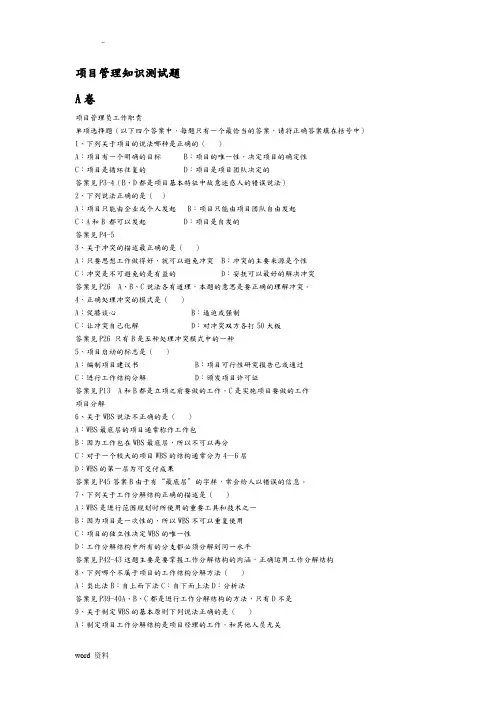
项目管理知识测试题A卷项目管理员工作职责单项选择题(以下四个答案中,每题只有一个最恰当的答案,请将正确答案填在括号中)1、下列关于项目的说法哪种是正确的()A:项目有一个明确的目标 B:项目的唯一性,决定项目的确定性C:项目是循环往复的 D:项目是项目团队决定的答案见P3-4(B、D都是项目基本特征中故意迷惑人的错误说法)2、下列说法正确的是()A:项目只能由企业或个人发起 B:项目只能由项目团队自由发起C:A和B 都可以发起 D:项目是自发的答案见P4-53、关于冲突的描述最正确的是()A:只要思想工作做得好,就可以避免冲突 B:冲突的主要来源是个性C:冲突是不可避免的是有益的 D:安抚可以最好的解决冲突答案见P26 A、B、C说法各有道理,本题的意思是要正确的理解冲突。
4、正确处理冲突的模式是()A:促膝谈心 B:逼迫或强制C:让冲突自己化解 D:对冲突双方各打50大板答案见P26 只有B是五种处理冲突模式中的一种5、项目启动的标志是()A:编制项目建议书 B:项目可行性研究报告已或通过C:进行工作结构分解 D:颁发项目许可证答案见P13 A和B都是立项之前要做的工作。
C是实施项目要做的工作项目分解6、关于WBS说法不正确的是()A:WBS最底层的项目通常称作工作包B:因为工作包在WBS最底层,所以不可以再分C:对于一个较大的项目WBS的结构通常分为4—6层D:WBS的第一层为可交付成果答案见P45答案B由于有“最底层”的字样,常会给人以错误的信息。
7、下列关于工作分解结构正确的描述是()A:WBS是进行范围规划时所使用的重要工具和技术之一B:因为项目是一次性的,所以WBS不可以重复使用C:项目的独立性决定WBS的唯一性D:工作分解结构中所有的分支都必须分解到同一水平答案见P42-43这题主要是要掌握工作分解结构的内涵,正确运用工作分解结构8、下列哪个不属于项目的工作结构分解方法()A:类比法B:自上而下法C:自下而上法D:分析法答案见P39-40A、B、C都是进行工作分解结构的方法,只有D不是9、关于制定WBS的基本原则下列说法正确的是()A:制定项目工作分解结构是项目经理的工作,和其他人员无关B:WBS中的一项工作是由多人来完成的,负责人也为多个C:WBS是可变的,不一定与工作任务的实际执行过程相一致D:下一级各项工作之和对于其上一级工作的完成是充分必要的答案见P5110、我们常说的项目责任矩阵是()A:WBS—RBS B:WBS—OBS C:WBS—CBS D:OBS—ABS答案见P37项目责任矩阵是项目工作分解结构与组织分解结构结合的产物。
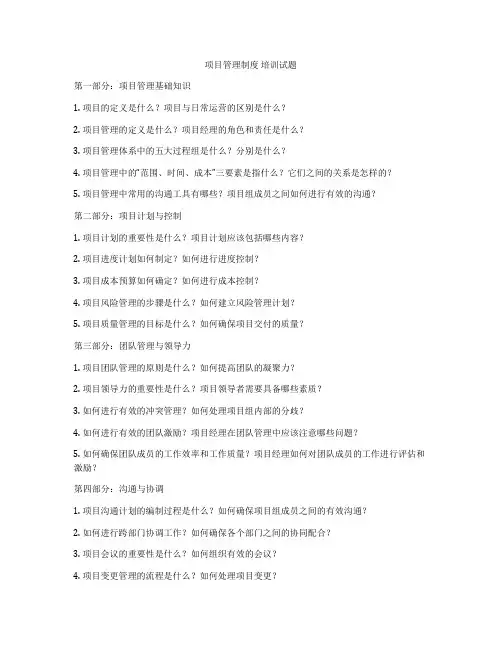
项目管理制度培训试题第一部分:项目管理基础知识1. 项目的定义是什么?项目与日常运营的区别是什么?2. 项目管理的定义是什么?项目经理的角色和责任是什么?3. 项目管理体系中的五大过程组是什么?分别是什么?4. 项目管理中的“范围、时间、成本”三要素是指什么?它们之间的关系是怎样的?5. 项目管理中常用的沟通工具有哪些?项目组成员之间如何进行有效的沟通?第二部分:项目计划与控制1. 项目计划的重要性是什么?项目计划应该包括哪些内容?2. 项目进度计划如何制定?如何进行进度控制?3. 项目成本预算如何确定?如何进行成本控制?4. 项目风险管理的步骤是什么?如何建立风险管理计划?5. 项目质量管理的目标是什么?如何确保项目交付的质量?第三部分:团队管理与领导力1. 项目团队管理的原则是什么?如何提高团队的凝聚力?2. 项目领导力的重要性是什么?项目领导者需要具备哪些素质?3. 如何进行有效的冲突管理?如何处理项目组内部的分歧?4. 如何进行有效的团队激励?项目经理在团队管理中应该注意哪些问题?5. 如何确保团队成员的工作效率和工作质量?项目经理如何对团队成员的工作进行评估和激励?第四部分:沟通与协调1. 项目沟通计划的编制过程是什么?如何确保项目组成员之间的有效沟通?2. 如何进行跨部门协调工作?如何确保各个部门之间的协同配合?3. 项目会议的重要性是什么?如何组织有效的会议?4. 项目变更管理的流程是什么?如何处理项目变更?5. 如何建立有效的项目报告机制?如何向上级领导和相关部门进行汇报?第五部分:项目收尾与总结1. 项目收尾的流程是什么?如何进行项目验收和交付?2. 项目总结的作用是什么?如何进行项目总结与经验总结?3. 项目知识管理的重要性是什么?如何建立项目知识库?4. 如何进行项目评估与改进?如何确保项目管理经验的传承和积累?5. 项目管理中常见的问题及解决方法有哪些?如何提高项目管理的水平和效率?以上是关于项目管理制度培训试题的内容,希望能为您的培训活动提供帮助。
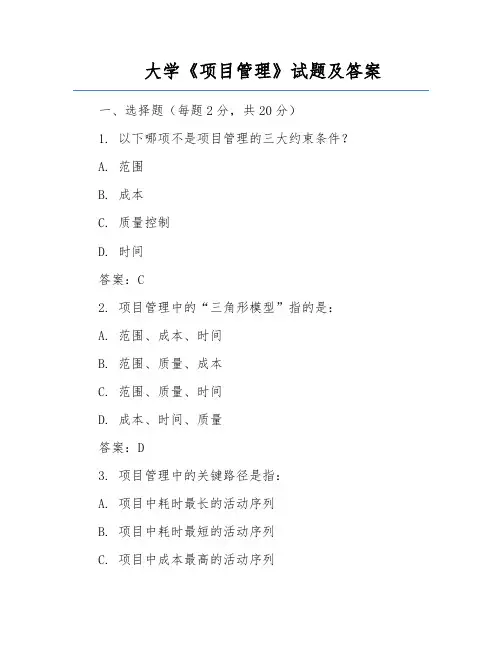
大学《项目管理》试题及答案一、选择题(每题2分,共20分)1. 以下哪项不是项目管理的三大约束条件?A. 范围B. 成本C. 质量控制D. 时间答案:C2. 项目管理中的“三角形模型”指的是:A. 范围、成本、时间B. 范围、质量、成本C. 范围、质量、时间D. 成本、时间、质量答案:D3. 项目管理中的关键路径是指:A. 项目中耗时最长的活动序列B. 项目中耗时最短的活动序列C. 项目中成本最高的活动序列D. 项目中成本最低的活动序列答案:A4. 项目管理计划包括以下哪几部分?A. 项目范围计划、项目进度计划、项目成本计划B. 项目范围计划、项目进度计划、项目质量管理计划C. 项目范围计划、项目进度计划、项目风险管理计划D. 项目范围计划、项目成本计划、项目风险管理计划答案:A5. 以下哪项不是项目团队的角色?A. 项目经理B. 项目助理C. 项目顾问D. 项目甲方答案:D6. 项目质量管理包括以下哪几个过程?A. 质量计划、质量保证、质量控制B. 质量计划、质量改进、质量控制C. 质量规划、质量保证、质量改进D. 质量规划、质量保证、质量控制答案:A7. 项目风险管理的目的是:A. 识别项目风险,制定应对策略B. 降低项目风险,提高项目成功率C. 评估项目风险,制定风险应对计划D. 监控项目风险,确保项目顺利进行答案:B8. 项目沟通管理包括以下哪几个过程?A. 沟通规划、信息发布、信息收集B. 沟通规划、信息发布、沟通监控C. 沟通规划、信息收集、沟通监控D. 信息发布、信息收集、沟通监控答案:B9. 项目采购管理包括以下哪几个过程?A. 采购规划、采购执行、采购控制B. 采购规划、采购谈判、采购控制C. 采购规划、采购执行、采购评价D. 采购规划、采购谈判、采购评价答案:A10. 项目收尾阶段的工作包括以下哪几项?A. 提交项目成果、项目总结、项目评价B. 提交项目成果、项目总结、项目验收C. 提交项目成果、项目评价、项目验收D. 提交项目成果、项目总结、项目验收、项目评价答案:B二、简答题(每题10分,共30分)1. 简述项目管理的五大过程。
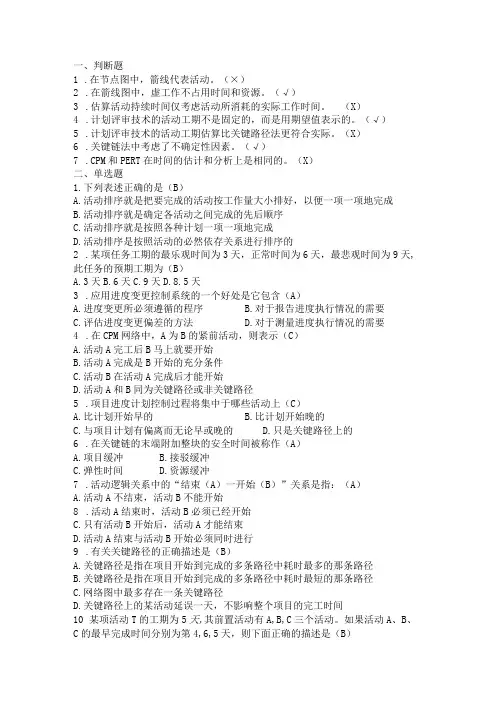
一、判断题1.在节点图中,箭线代表活动。
(×)2.在箭线图中,虚工作不占用时间和资源。
(√)3.估算活动持续时间仅考虑活动所消耗的实际工作时间。
(X)4.计划评审技术的活动工期不是固定的,而是用期望值表示的。
(√)5.计划评审技术的活动工期估算比关键路径法更符合实际。
(X)6.关键链法中考虑了不确定性因素。
(√)7.CPM和PERT在时间的估计和分析上是相同的。
(X)二、单选题1.下列表述正确的是(B)A.活动排序就是把要完成的活动按工作量大小排好,以便一项一项地完成B.活动排序就是确定各活动之间完成的先后顺序C.活动排序就是按照各种计划一项一项地完成D.活动排序是按照活动的必然依存关系进行排序的2.某项任务工期的最乐观时间为3天,正常时间为6天,最悲观时间为9天,此任务的预期工期为(B)A.3天B.6天C.9天D.8.5天3.应用进度变更控制系统的一个好处是它包含(A)A.进度变更所必须遵循的程序B.对于报告进度执行情况的需要C.评估进度变更偏差的方法D.对于测量进度执行情况的需要4.在CPM网络中,A为B的紧前活动,则表示(C)A.活动A完工后B马上就要开始B.活动A完成是B开始的充分条件C.活动B在活动A完成后才能开始D.活动A和B同为关键路径或非关键路径5.项目进度计划控制过程将集中于哪些活动上(C)A.比计划开始早的B.比计划开始晚的C.与项目计划有偏离而无论早或晚的D.只是关键路径上的6.在关键链的末端附加整块的安全时间被称作(A)A.项目缓冲B.接驳缓冲C.弹性时间D.资源缓冲7.活动逻辑关系中的“结束(A)一开始(B)”关系是指:(A)A.活动A不结束,活动B不能开始8.活动A结束时,活动B必须已经开始C.只有活动B开始后,活动A才能结束D.活动A结束与活动B开始必须同时进行9.有关关键路径的正确描述是(B)A.关键路径是指在项目开始到完成的多条路径中耗时最多的那条路径B.关键路径是指在项目开始到完成的多条路径中耗时最短的那条路径C.网络图中最多存在一条关键路径D.关键路径上的某活动延误一天,不影响整个项目的完工时间10某项活动T的工期为5天,其前置活动有A,B,C三个活动。
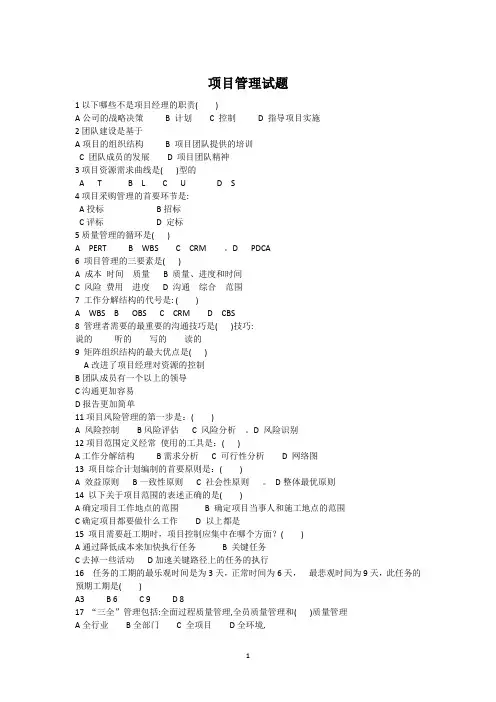
项目管理试题1以下哪些不是项目经理的职责( )A公司的战略决策 B 计划 C 控制 D 指导项目实施2团队建设是基于A项目的组织结构 B 项目团队提供的培训C 团队成员的发展D 项目团队精神3项目资源需求曲线是( )型的A TB LC UD S4项目采购管理的首要环节是:A投标B招标C评标 D 定标5质量管理的循环是( )A PERTB WBSC CRM 。
D PDCA6 项目管理的三要素是( )A 成本时间质量B 质量、进度和时间C 风险费用进度D 沟通综合范围7 工作分解结构的代号是: ( )A WBSB OBSC CRMD CBS8 管理者需要的最重要的沟通技巧是( )技巧:说的听的写的读的9 矩阵组织结构的最大优点是( )A改进了项目经理对资源的控制B团队成员有一个以上的领导C沟通更加容易D报告更加简单11项目风险管理的第一步是:( )A 风险控制B风险评估 C 风险分析。
D 风险识别12项目范围定义经常使用的工具是:( )A工作分解结构B需求分析 C 可行性分析 D 网络图13 项目综合计划编制的首要原则是:( )A 效益原则B一致性原则 C 社会性原则。
D整体最优原则14 以下关于项目范围的表述正确的是( )A确定项目工作地点的范围 B 确定项目当事人和施工地点的范围C确定项目都要做什么工作 D 以上都是15 项目需要赶工期时,项目控制应集中在哪个方面?( )A通过降低成本来加快执行任务 B 关键任务C去掉一些活动D加速关键路径上的任务的执行16 任务的工期的最乐观时间是为3天,正常时间为6天,最悲观时间为9天,此任务的预期工期是( )A3 B 6 C 9 D 817 “三全”管理包括:全面过程质量管理,全员质量管理和( )质量管理A全行业B全部门 C 全项目D全环境,18 项目构思的主体是项目的( ):A承包商B业主C投资方 D 政府19 项目管理的目标就是:( )A 让投资方满意B 让社会满意C 让政府满意D 让项目客户满意20 项目质量审计发生在项目质量管理的哪个阶段( )A 质量计划B 质量保证。
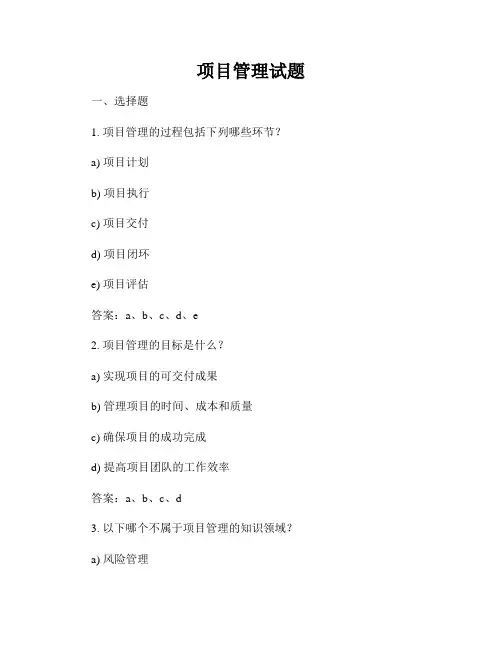
项目管理试题一、选择题1. 项目管理的过程包括下列哪些环节?a) 项目计划b) 项目执行c) 项目交付d) 项目闭环e) 项目评估答案:a、b、c、d、e2. 项目管理的目标是什么?a) 实现项目的可交付成果b) 管理项目的时间、成本和质量c) 确保项目的成功完成d) 提高项目团队的工作效率答案:a、b、c、d3. 以下哪个不属于项目管理的知识领域?a) 风险管理b) 范围管理c) 人力资源管理d) 销售管理答案:d4. 项目干系人的定义是指哪些人?a) 项目发起人和执行人员b) 项目相关方,对项目有利益关系的人员c) 项目管理团队成员d) 所有参与项目的人员答案:b5. 以下哪项不是项目管理的核心技能?a) 沟通与协调能力b) 决策能力c) 领导能力d) 技术专业能力答案:d二、问答题1. 请简述项目管理的五个过程组和十个知识领域。
答:项目管理的五个过程组包括:- 启动过程组:定义项目启动,确定项目目标和约束条件。
- 规划过程组:确定项目的范围、时间、成本等计划。
- 执行过程组:执行项目计划,组织团队执行工作。
- 监控过程组:监控项目进展,调整计划和资源。
- 收尾过程组:验收项目交付成果,关闭项目。
项目管理的十个知识领域包括:- 整合管理:协调各个项目管理过程,确保项目目标的实现。
- 范围管理:定义和管理项目范围。
- 时间管理:制定项目进度计划,确保项目按时完成。
- 成本管理:估算和控制项目成本,确保项目在预算范围内。
- 质量管理:规划和控制项目质量,确保项目交付的成果符合要求。
- 人力资源管理:规划和管理项目团队,提高团队绩效。
- 沟通管理:制定和执行项目沟通计划,确保及时有效地传递信息。
- 风险管理:识别、评估和应对项目风险,降低不确定性。
- 采购管理:规划和进行项目采购,确保项目所需资源的供应。
- 相关方管理:识别、分析和管理项目相关方,维护项目利益关系。
2. 请简述项目干系人管理的重要性以及常用的干系人管理工具。
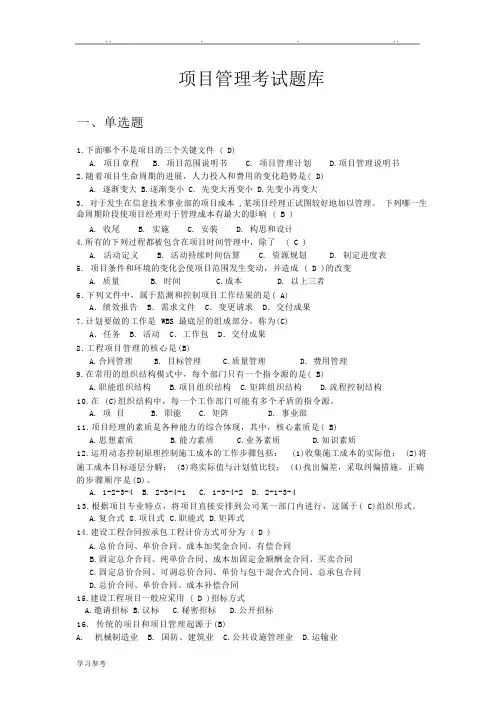
项目管理考试题库一、单选题1.下面哪个不是项目的三个关键文件 ( D)A. 项目章程B. 项目范围说明书C. 项目管理计划D.项目管理说明书2.随着项目生命周期的进展,人力投入和费用的变化趋势是( D)A. 逐渐变大B.逐渐变小C. 先变大再变小D.先变小再变大3. 对于发生在信息技术事业部的项目成本 ,某项目经理正试图较好地加以管理。
下列哪一生命周期阶段使项目经理对于管理成本有最大的影响 ( B )A. 收尾B. 实施C. 安装D. 构思和设计4.所有的下列过程都被包含在项目时间管理中,除了 ( C )A. 活动定义B. 活动持续时间估算C. 资源规划D. 制定进度表5. 项目条件和环境的变化会使项目范围发生变动,并造成 ( D )的改变A. 质量B. 时间C.成本D. 以上三者6.下列文件中,属于监测和控制项目工作结果的是( A)A.绩效报告 B.需求文件 C.变更请求 D.交付成果7.计划要做的工作是 WBS 最底层的组成部分,称为(C)A.任务 B.活动 C.工作包 D.交付成果8.工程项目管理的核心是(B)A.合同管理B. 目标管理C.质量管理D. 费用管理9.在常用的组织结构模式中,每个部门只有一个指令源的是( B)A.职能组织结构B.项目组织结构C.矩阵组织结构D.流程控制结构10.在 (C)组织结构中,每一个工作部门可能有多个矛盾的指令源。
A. 项目B. 职能C. 矩阵D. 事业部11.项目经理的素质是各种能力的综合体现,其中,核心素质是( B)A.思想素质B.能力素质C.业务素质D.知识素质12.运用动态控制原理控制施工成本的工作步骤包括: (1)收集施工成本的实际值; (2)将施工成本目标逐层分解; (3)将实际值与计划值比较; (4)找出偏差,采取纠偏措施。
正确的步骤顺序是(D)。
A. 1-2-3-4B. 2-3-4-1C. 1-3-4-2D. 2-1-3-413.根据项目专业特点,将项目直接安排到公司某一部门内进行,这属于( C)组织形式。
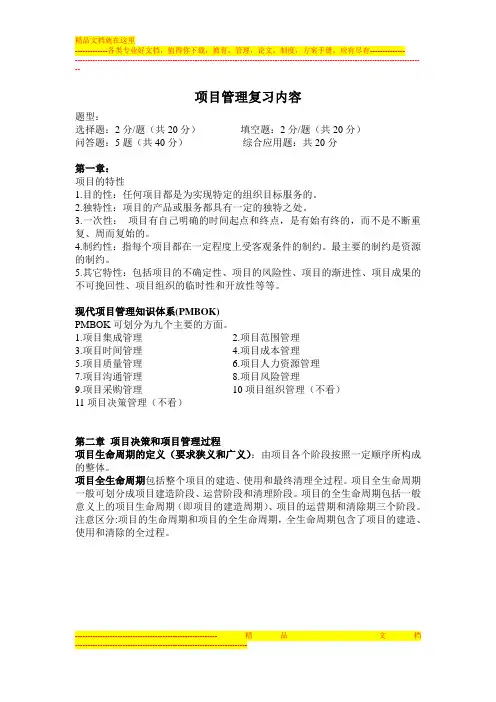
项目管理复习内容题型:选择题:2分/题(共20分)填空题:2分/题(共20分)问答题:5题(共40分)综合应用题:共20分第一章:项目的特性1.目的性:任何项目都是为实现特定的组织目标服务的。
2.独特性:项目的产品或服务都具有一定的独特之处。
3.一次性:项目有自己明确的时间起点和终点,是有始有终的,而不是不断重复、周而复始的。
4.制约性:指每个项目都在一定程度上受客观条件的制约。
最主要的制约是资源的制约。
5.其它特性:包括项目的不确定性、项目的风险性、项目的渐进性、项目成果的不可挽回性、项目组织的临时性和开放性等等。
现代项目管理知识体系(PMBOK)PMBOK可划分为九个主要的方面。
1.项目集成管理2.项目范围管理3.项目时间管理4.项目成本管理5.项目质量管理6.项目人力资源管理7.项目沟通管理8.项目风险管理9.项目采购管理10项目组织管理(不看)11项目决策管理(不看)第二章项目决策和项目管理过程项目生命周期的定义(要求狭义和广义):由项目各个阶段按照一定顺序所构成的整体。
项目全生命周期包括整个项目的建造、使用和最终清理全过程。
项目全生命周期一般可划分成项目建造阶段、运营阶段和清理阶段。
项目的全生命周期包括一般意义上的项目生命周期(即项目的建造周期)、项目的运营期和清除期三个阶段。
注意区分:项目的生命周期和项目的全生命周期,全生命周期包含了项目的建造、使用和清除的全过程。
项目定义与决策阶段工作图项目决策与项目评估的相互关系:第五章项目产出物范围(结合案例来复习)项目产出物的范围是指最终项目成果所包括的范围项目工作范围是指实现项目目标和生成项目产出物所做的全部工作的范围项目工作分解项目范围规划项目范围控制项目范围确认项目范围管理计划项目范围管理方法项目范围说明书(更新)项目范围主观项目范围客观项目范围项目实施范围项目范围项目工作分解项目工作分解结构项目范围界定项目范围管理主要内容的示意图1.项目范围的规划---指在项目开始初期根据项目章程、项目初步范围说明书、项目的要求等做的项目范围管理的计划安排,内容包括对未来开展项目范围管理的方法和具体内容与要求等方面的规定。
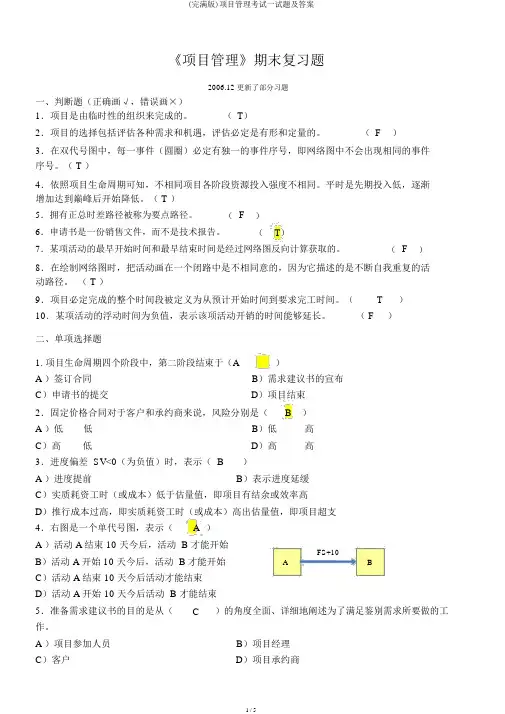
《项目管理》期末复习题2006.12 更新了部分习题一、判断题(正确画√,错误画×)1.项目是由临时性的组织来完成的。
(T)2.项目的选择包括评估各种需求和机遇,评估必定是有形和定量的。
(F)3.在双代号图中,每一事件(圆圈)必定有独一的事件序号,即网络图中不会出现相同的事件序号。
( T )4.依照项目生命周期可知,不相同项目各阶段资源投入强度不相同。
平时是先期投入低,逐渐增加达到巅峰后开始降低。
( T )5.拥有正总时差路径被称为要点路径。
(F)6.申请书是一份销售文件,而不是技术报告。
(T)7.某项活动的最早开始时间和最早结束时间是经过网络图反向计算获取的。
(F)8.在绘制网络图时,把活动画在一个闭路中是不相同意的,因为它描述的是不断自我重复的活动路径。
( T )9.项目必定完成的整个时间段被定义为从预计开始时间到要求完工时间。
(T)10.某项活动的浮动时间为负值,表示该项活动开销的时间能够延长。
( F)二、单项选择题1. 项目生命周期四个阶段中,第二阶段结束于(A)A )签订合同B)需求建议书的宣布C)申请书的提交D)项目结束2.固定价格合同对于客户和承约商来说,风险分别是(B)A )低低B)低高C)高低D)高高3.进度偏差 SV<0(为负值)时,表示( B)A )进度提前B)表示进度延缓C)实质耗资工时(或成本)低于估量值,即项目有结余或效率高D)推行成本过高,即实质耗资工时(或成本)高出估量值,即项目超支4.右图是一个单代号图,表示(A)A )活动 A 结束 10 天今后,活动B 才能开始FS+10B)活动 A 开始 10 天今后,活动 B 才能开始A BC)活动 A 结束 10 天今后活动才能结束D)活动 A 开始 10 天今后活动 B 才能结束5.准备需求建议书的目的是从(C)的角度全面、详细地阐述为了满足鉴别需求所要做的工作。
A )项目参加人员B)项目经理C)客户D)项目承约商三、多项选择题1.以下工作中属于项目的是(A) 策划一场婚礼)B)开发一个软件C)为人民服务D)主持一次会议E)管理大楼的卫生服务2.项目目标平时用以下要素来表示( A )工作范围)B)顾客满意度C)进度计划D)成本E)工作人员3. 下面对单代号图描述正确的选项是()A )节点表示活动B)箭线表示活动C)箭线表示活动(工作)之间的逻辑关系。
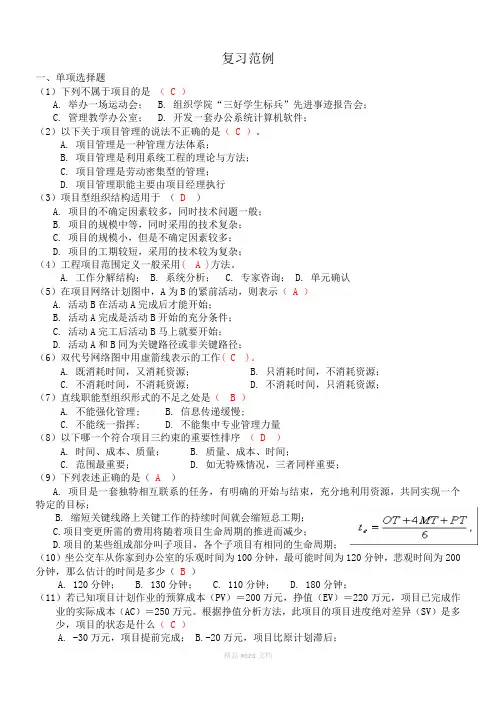
复习范例一、单项选择题(1)下列不属于项目的是( C )A. 举办一场运动会;B. 组织学院“三好学生标兵”先进事迹报告会;C. 管理教学办公室;D. 开发一套办公系统计算机软件;(2)以下关于项目管理的说法不正确的是( C )。
A. 项目管理是一种管理方法体系;B. 项目管理是利用系统工程的理论与方法;C. 项目管理是劳动密集型的管理;D. 项目管理职能主要由项目经理执行(3)项目型组织结构适用于( D)A. 项目的不确定因素较多,同时技术问题一般;B. 项目的规模中等,同时采用的技术复杂;C. 项目的规模小,但是不确定因素较多;D. 项目的工期较短,采用的技术较为复杂;(4)工程项目范围定义一般采用( A )方法。
A. 工作分解结构;B. 系统分析;C. 专家咨询;D. 单元确认(5)在项目网络计划图中,A为B的紧前活动,则表示( A )A. 活动B在活动A完成后才能开始;B. 活动A完成是活动B开始的充分条件;C. 活动A完工后活动B马上就要开始;D. 活动A和B同为关键路径或非关键路径;(6)双代号网络图中用虚箭线表示的工作( C )。
A. 既消耗时间,又消耗资源;B. 只消耗时间,不消耗资源;C. 不消耗时间,不消耗资源;D. 不消耗时间,只消耗资源;(7)直线职能型组织形式的不足之处是( B )A. 不能强化管理;B. 信息传递缓慢;C. 不能统一指挥;D. 不能集中专业管理力量(8)以下哪一个符合项目三约束的重要性排序( D )A. 时间、成本、质量;B. 质量、成本、时间;C. 范围最重要;D. 如无特殊情况,三者同样重要;(9)下列表述正确的是( A )A. 项目是一套独特相互联系的任务,有明确的开始与结束,充分地利用资源,共同实现一个特定的目标;B. 缩短关键线路上关键工作的持续时间就会缩短总工期;C.项目变更所需的费用将随着项目生命周期的推进而减少;D.项目的某些组成部分叫子项目,各个子项目有相同的生命周期;(10)坐公交车从你家到办公室的乐观时间为100分钟,最可能时间为120分钟,悲观时间为200分钟,那么估计的时间是多少(B)A. 120分钟;B. 130分钟;C. 110分钟;D. 180分钟;(11)若已知项目计划作业的预算成本(PV)=200万元,挣值(EV)=220万元,项目已完成作业的实际成本(AC)=250万元。
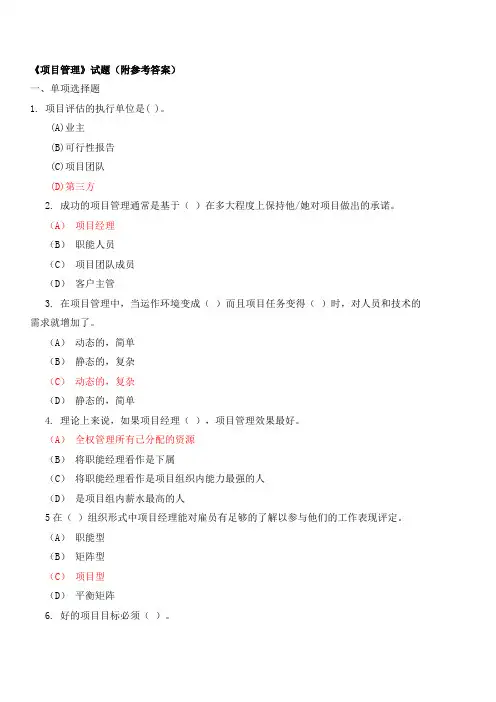
《项目管理》试题(附参考答案)一、单项选择题1. 项目评估的执行单位是( )。
(A)业主(B)可行性报告(C)项目团队(D)第三方2. 成功的项目管理通常是基于()在多大程度上保持他/她对项目做出的承诺。
(A)项目经理(B)职能人员(C)项目团队成员(D)客户主管3. 在项目管理中,当运作环境变成()而且项目任务变得()时,对人员和技术的需求就增加了。
(A)动态的,简单(B)静态的,复杂(C)动态的,复杂(D)静态的,简单4. 理论上来说,如果项目经理(),项目管理效果最好。
(A)全权管理所有已分配的资源(B)将职能经理看作是下属(C)将职能经理看作是项目组织内能力最强的人(D)是项目组内薪水最高的人5在()组织形式中项目经理能对雇员有足够的了解以参与他们的工作表现评定。
(A)职能型(B)矩阵型(C)项目型(D)平衡矩阵6. 好的项目目标必须()。
(A)在建立时不考虑资源限制(B)是可衡量的,无形的,以及能证实的(C)是现实的,可以达到的(D)是概括而不是具体的7. 项目在()组织中最不被重视。
(A)平衡矩阵型(B)强矩阵型(C)项目协调员型(D)职能型8. 控制发生在()。
(A)整个项目中不断变化的基础上(B)项目生命周期的每个阶段结束时,以评估是否达到项目目标(C)每个计划过程结束时(D)整个执行过程及其它需要的过程的界面上9. 对项目而言,“一次性”指()。
(A)项目周期短(B)每个项目都有明确的起止时间(C)项目将在未来不能确定的时候完成(D)项目随时可能取消10. 项目经理仅基于其在组织中的位置而产生的三种权力是()。
(A)正式,奖励,惩罚(B)奖励,指示,正式(C)专家,指示,正式(D)奖励,专家,指示11. ()包含在项目生命周期的实施阶段中。
(A)建立和计划(B)执行和控制(C)计划和执行(D)概念和计划12. 网络计划工期优化,主要通过()来实现。
(A)利用总时差(B)利用自由时差(C)压缩关键工作持续时间(D)压缩非关键工作持续时间13. 项目可被定义为( )。
欢迎共阅项目管理知识测试题A卷项目管理员工作职责单项选择题(以下四个答案中,每题只有一个最恰当的答案,请将正确答案填在括号中)1、下列关于项目的说法哪种是正确的()A:项目有一个明确的目标B:项目的唯一性,决定项目的确定性C:项目是循环往复的D:项目是项目团队决定的答案见P3-4(B、D都是项目基本特征中故意迷惑人的错误说法)2、下列说法正确的是()A:项目只能由企业或个人发起B:项目只能由项目团队自由发起C:A和B 都可以发起D:项目是自发的答案见P4-53、关于冲突的描述最正确的是()A:只要思想工作做得好,就可以避免冲突B:冲突的主要来源是个性C:冲突是不可避免的是有益的D:安抚可以最好的解决冲突答案见P26 A、B、C说法各有道理,本题的意思是要正确的理解冲突。
4、正确处理冲突的模式是()A:促膝谈心B:逼迫或强制C:让冲突自己化解D:对冲突双方各打50大板答案见P26 只有B是五种处理冲突模式中的一种5、项目启动的标志是()A:编制项目建议书B:项目可行性研究报告已或通过C:进行工作结构分解D:颁发项目许可证答案见P13 A和B都是立项之前要做的工作。
C是实施项目要做的工作项目分解6、关于WBS说法不正确的是()A:WBS最底层的项目通常称作工作包B:因为工作包在WBS最底层,所以不可以再分C:对于一个较大的项目WBS的结构通常分为4—6层D:WBS的第一层为可交付成果答案见P45答案B由于有“最底层”的字样,常会给人以错误的信息。
7、下列关于工作分解结构正确的描述是()A:WBS是进行范围规划时所使用的重要工具和技术之一B:因为项目是一次性的,所以WBS不可以重复使用C:项目的独立性决定WBS的唯一性D:工作分解结构中所有的分支都必须分解到同一水平答案见P42-43这题主要是要掌握工作分解结构的内涵,正确运用工作分解结构8、下列哪个不属于项目的工作结构分解方法()A:类比法B:自上而下法C:自下而上法D:分析法答案见P39-40A、B、C都是进行工作分解结构的方法,只有D不是9、关于制定WBS的基本原则下列说法正确的是()A:制定项目工作分解结构是项目经理的工作,和其他人员无关B:WBS中的一项工作是由多人来完成的,负责人也为多个C:WBS是可变的,不一定与工作任务的实际执行过程相一致D:下一级各项工作之和对于其上一级工作的完成是充分必要的答案见P5110、我们常说的项目责任矩阵是()A:WBS—RBS B:WBS—OBS C:WBS—CBS D:OBS—ABS答案见P37项目责任矩阵是项目工作分解结构与组织分解结构结合的产物。
〈项目管理〉复习题一、名词解释:1. 项目管理:项冃管理是根据项目的实际环境,通过各方干系人的合作努力,把各种资源应用于项目,达到项目的目标要求,满足或超过项目干系人的需求和期望的过程。
2. 干系人:包括项目当事人和其利益受该项目影响的个人和组织。
3. 项目管理成本:指为组织管理项目所发生的成木支出,此项目成本为项目的简介成木,主要包括:人T 费、固定资产使用费、工具用具使用费、办公费、差旅交通费、保险费、工程保修费、工程排污费、外单位管理费等。
一、4.项目采购:包含着以不同方式从系统外部获得货物、工程和服务的整个采办过稈。
5. 项目生命期:通常将项目从开始到结束经历的备个阶段的序列叫做项目生命期。
6. 项|-|章程:项H章程是正式授权一个项H和项H资金的文件,由项H发起人或者项H组织Z外的主办人颁发。
项目章程任命项目经理,授权其使用组织的资源开展项目活动。
7. 范围说明书:范帼说明书具体说明了为什么要进行这个项目,明确了项目的目标和主要的可交付成果,是项目管理团队和业主Z间签订协议的基础,也是未来项目实施的基础。
&关键路线法:对于一个项目而言,只有项目网络图屮的最长的或耗时最多的活动路线完成Z后,项目才能结束,这条最长的活动路线就叫关键路线。
9.项目直接成木:与项目的形成有直接关系的那部分成木,也就是说,成木的发生与项目是育接对应的。
这些成木包括直接人工费、直接材料费、船机使用费、其他直接费等。
10•项目管理成本:指为组织管理项li所发生的成木支出,此项li成本为项H的简介成本,主要包括:人工费、固定资产使用费、T具用具使用费、办公费、并旅交通费、保险费、T程保修费、工程排污费、外单位管理费等。
11. W控制:质量控制是关于活动和技术的集合性术语,在执行质量控制过程屮,活动与技术旨在创造特定的质最特征,这种活动包括不断监督和控制过程、识别和消除产生的原因,利用统计过程控制减少可变性来增加这些过程的效率。
项目管理大学试题及答案一、单项选择题(每题1分,共10分)1. 项目管理的核心是什么?A. 项目成本B. 项目范围C. 项目时间D. 项目质量答案:B2. 项目管理的五大过程组包括哪些?A. 启动、规划、执行、监控、收尾B. 计划、实施、控制、结束、评估C. 定义、执行、监控、控制、结束D. 启动、计划、执行、监控、结束答案:A3. 项目管理知识体系指南(PMBOK)是由哪个组织制定的?A. 国际项目管理协会(IPMA)B. 美国项目管理协会(PMI)C. 国际标准化组织(ISO)D. 国际质量协会(IQA)答案:B4. 以下哪一项不是项目的特点?A. 临时性B. 独特性C. 重复性D. 目标性答案:C5. 项目风险管理的目的是?A. 消除风险B. 转移风险C. 识别风险D. 减少风险的不确定性答案:D6. 项目章程是由谁批准的?A. 项目经理B. 项目团队C. 项目发起人D. 项目客户答案:C7. 项目管理计划不包括以下哪项内容?A. 范围管理计划B. 进度管理计划C. 风险管理计划D. 项目成果答案:D8. 项目生命周期的哪个阶段通常涉及最多的成本?A. 启动阶段B. 规划阶段C. 执行阶段D. 收尾阶段答案:C9. 敏捷项目管理中的核心概念是什么?A. 固定时间B. 固定范围C. 固定成本D. 适应性答案:D10. 项目变更控制委员会(CCB)的主要职能是什么?A. 批准项目章程B. 批准项目变更C. 制定项目计划D. 执行项目工作答案:B二、多项选择题(每题2分,共10分)1. 以下哪些是项目干系人?A. 项目发起人B. 项目经理C. 项目客户D. 项目团队成员E. 项目供应商答案:ABCDE2. 项目范围管理包括以下哪些内容?A. 定义范围B. 创建工作分解结构(WBS)C. 范围验证D. 范围控制E. 进度控制答案:ABCD3. 项目进度管理的工具和技术包括哪些?A. 关键路径法(CPM)B. 甘特图C. 资源平衡D. 项目评审技术(PERT)E. 风险管理答案:ABD4. 项目质量管理的步骤包括哪些?A. 质量规划B. 质量保证C. 质量控制D. 成本控制E. 风险控制答案:ABC5. 项目沟通管理的组成部分包括哪些?A. 沟通计划B. 信息分发C. 绩效报告D. 风险管理E. 利益相关者管理答案:ABC三、简答题(每题5分,共20分)1. 简述项目范围管理的重要性。
项目管理员考试试题及答案一、选择题1. 项目管理的目标是:A. 实现项目利润最大化B. 确保项目按时交付C. 提高团队合作效率D. 完善公司流程管理答案:B2. 以下哪个不属于项目生命周期的阶段?A. 规划B. 执行C. 控制D. 终止答案:D3. 项目管理中三个约束因素是:A. 范围、资源、进度B. 人员、成本、风险C. 范围、时间、质量D. 风险、资源、时间答案:C二、填空题1. 项目时间管理的主要工具是__网络图__。
2. 可能导致项目风险的因素包括__技术变化__、__人员变动__和__市场变化__。
三、简答题1. 请简述项目范围管理的重要性及其核心过程。
答案:项目范围管理是确保项目按照预期交付的关键过程。
它包括定义项目的目标、可交付成果和工作范围,以及控制范围的变更。
项目范围管理可以确保项目始终保持在预定的边界内,避免范围蔓延和项目目标的模糊化。
2. 请简要描述项目关键路径的概念,以及它对项目进度管理的作用。
答案:项目关键路径是指在项目网络图中,最长时间路径所经过的一系列关键活动。
关键路径上的活动不能延误,否则会导致整个项目的延误。
因此,关键路径对项目进度管理非常重要。
项目经理可以通过对关键路径上活动的优化和控制,来确保项目能够按时完成。
四、案例分析题请根据以下情景回答问题。
某公司计划开展一个新产品的研发项目,该项目具有一定的技术挑战性。
为了确保项目的成功,公司决定聘请一个项目管理员进行项目管理,并组建一个高效的团队。
1. 你认为在项目初期,项目管理员应该重点关注哪些事项?为什么?答案:在项目初期,项目管理员应该重点关注以下事项:- 确定项目的目标、范围和约束条件,并与相关利益相关者进行沟通和确认,以确保项目始终朝着正确的方向前进。
- 制定详细的项目计划,包括时间安排、资源需求和风险评估,以确保项目能够按时、按质按量地完成。
- 确保团队成员的合理分工和协作,以提高团队效率和项目绩效。
2. 项目管理员应该如何应对项目中的风险?答案:项目管理员可以采取以下措施来应对项目中的风险:- 进行风险识别和评估,确定潜在风险的可能性和影响程度。
项目管理复习题及答案一、单项选择题1. 项目管理的主要目标是:A. 降低成本B. 提高效率C. 按时、按预算、按质量完成项目D. 增加收益答案:C2. 项目范围管理的核心是:A. 范围定义B. 范围变更控制C. 范围确认D. 范围规划答案:A3. 在项目管理中,风险矩阵通常用于:A. 确定项目优先级B. 评估项目风险的严重性C. 制定项目时间表D. 分配项目资源答案:B4. 项目团队建设的五个阶段不包括:A. 形成B. 震荡C. 规范D. 执行答案:D5. 项目质量管理中,PDCA循环是指:A. 计划-执行-检查-行动B. 计划-定义-控制-评估C. 计划-设计-检查-调整D. 计划-实施-检查-评估答案:A二、多项选择题6. 以下哪些是项目成功的关键因素?A. 明确的项目目标B. 有效的沟通C. 充足的资源D. 严格的时间管理答案:A, B, C, D7. 项目风险管理包括哪些步骤?A. 风险识别B. 风险评估C. 风险应对D. 风险监控答案:A, B, C, D8. 项目时间管理的工具和技术包括:A. Gantt 图B. PERT 图C. CPM 图D. 网络图答案:A, B, C, D9. 项目成本管理中,以下哪些是成本估算的方法?A. 类比估算B. 参数估算C. 专家判断D. 储备分析答案:A, B, C, D10. 项目沟通管理的目的是:A. 确保信息的准确传递B. 促进团队成员之间的协作C. 减少误解和冲突D. 记录项目进展答案:A, B, C, D三、简答题11. 简述项目管理的五大过程组。
答案:项目管理的五大过程组包括:启动过程组、规划过程组、执行过程组、监控和控制过程组以及收尾过程组。
12. 描述项目范围变更控制的重要性。
答案:项目范围变更控制的重要性在于确保项目目标和范围的一致性,防止项目范围蔓延,确保项目资源的有效利用,并且维护项目干系人的期望。
四、案例分析题13. 假设你是一个项目经理,你的团队正在开发一个新的软件产品。
第五章一、单选题1、在施工项目质量管理中,利用ABC分类法确定质量管理的重点是()。
A、A类因素B、B类因素C、C类因素D、D类因素2、影响施工项目的质量的因素主要有()A、人、材料、机械B、方法和环境C、人、材料、机械、方法、环境D、人、材料、机械、方法、环境和管理3、在施工项目质量控制中,对施工技术方案的控制属于()A、机械设备的控制B、人的控制C、施工方法的控制D、环境的控制4、在施工项目质量控制中,建立现场施工组织系统运行机制属于()A、机械设备的控制B、人的控制C、施工方法的控制D、环境的控制5、通过对()进行分析和观察,可以系统地整理分析某个质量问题(结果)及其产生的原因之间的关系。
A、排列图B、直方图C、因果分析图D、相关图6、影响施工项目的质量主要有五大因素,通常称为4M1E,分别是()。
A、人、材料、设备、技术、环境B、劳动者、劳动工具、劳动对象、劳动环境C、人、材料、机械、方法、环境D、劳动者、劳动工具、劳动对象、劳动方法7、质量管理中采用的控制图是利用什么规律,来识别生产过程中的异常因素,控制由系统性原因造成的质量波动,保证工序处于控制状态。
()A、偶然性原因被称为正常因素,其或在技术上难以测量,且难以消除,难以避免,或在经济上不值得消除。
B、系统性原因被称为异常因素,它对质量波动影响很大,要产生次品或废品,而这些因素是容易识别,也是可以避免的。
C、产品质量特征值分布服从正态分布。
D、绘制控制图的目的是分析判断生产过程是否处于稳定状态。
二、多选题1、检验批质量合格的条件为()A、主控项目的质量经抽样检验合格B、一般项目的质量经抽样检验合格C、质量控制资料完整D、观感质量符合要求E、具有完整的施工操作依据、质量检查记录2、施工项目质量事中控制措施主要有()。
A、施工事件有汇报、施工有计划、B、施工过程交接有检查、质量预控有对策、施工项目有方案、C、图纸会审有记录、技术措施有交底、配制材料有试验、D、隐蔽工程有验收、设计变更有手续、质量处理有复查、E、成品保护有措施、质量文件有档案。
Chapter 5: Project Scope ManagementTRUE/FALSE1. Scope refers to all the work involved in creating the products of the project and the processes used tocreate them.ANS: TOne of the most important and most difficult aspects of project management is defining the scope of a project. Scope refers to all the work involved in creating the products of the project and the processes used to create them.PTS: 1 DIF: Difficulty: Easy REF: p.188OBJ: LO:5-1 NAT: BUSPROG: TechnologyTOP: What Is Project Scope Management? KEY: Bloom's: Knowledge2. Deliverables are only product-related, such as a piece of hardware or software.ANS: FDeliverables can be product-related, such as a piece of hardware or software, or process-related, such as a planning document or meeting minutes.PTS: 1 DIF: Difficulty: Moderate REF: p.188OBJ: LO:5-1 NAT: BUSPROG: TechnologyTOP: What Is Project Scope Management? KEY: Bloom's: Knowledge3. Project scope management includes the processes involved in defining and controlling what is or is notincluded in a project.ANS: TProject scope management includes the processes involved in defining and controlling what work is or is not included in a project. It ensures that the project team and stakeholders have the sameunderstanding of what products the project will produce and what processes the project team will use to produce them.PTS: 1 DIF: Difficulty: Moderate REF: p.188OBJ: LO:5-1 NAT: BUSPROG: TechnologyTOP: What Is Project Scope Management? KEY: Bloom's: Knowledge4. The scope management plan can be informal and broad or formal and detailed, based on the needs ofthe project.ANS: TThe scope management plan is a subsidiary part of the project management plan. It can be informal and broad or formal and detailed, based on the needs of the project.PTS: 1 DIF: Difficulty: Moderate REF: p.189OBJ: LO:5-2 NAT: BUSPROG: TechnologyTOP: Planning Scope Management KEY: Bloom's: Comprehension5. The project’s size, complexity, importance, and other factors do not affect how much effort is spent oncollecting requirements for scope planning.The project’s size, complexity, importanc e, and other factors affect how much effort is spent oncollecting requirements.PTS: 1 DIF: Difficulty: Moderate REF: p.194OBJ: LO:5-3 NAT: BUSPROG: Technology TOP: Collecting Requirements KEY: Bloom's: Comprehension6. Information from the project charter provides a basis for further defining the project scope.ANS: TThe charter describes the high-level scope, time, and cost goals for the project objectives and success criteria, a general approach to accomplishing the project’s goals, and the main roles andresponsibilities of important project stakeholders.PTS: 1 DIF: Difficulty: Moderate REF: p.195OBJ: LO: 5-4 NAT: BUSPROG: Technology TOP: Defining ScopeKEY: Bloom's: Knowledge7. Project scope statements must include the project boundaries, constraints, and assumptions.ANS: FProject scope statements should include at least a product scope description, product user acceptance criteria, and detailed information on all project deliverables. It is also helpful to document otherscope-related information, such as the project boundaries, constraints, and assumptions.PTS: 1 DIF: Difficulty: Moderate REF: p.195OBJ: LO: 5-4 NAT: BUSPROG: Technology TOP: Defining ScopeKEY: Bloom's: Knowledge8. The scope of a project is clear and specific from the start.ANS: FAs time progresses, the scope of a project should become more clear and specific.PTS: 1 DIF: Difficulty: Easy REF: p.195OBJ: LO:5-4 NAT: BUSPROG: Technology TOP: Defining ScopeKEY: Bloom's: Comprehension9. Many information technology projects also require detailed functional and design specifications fordeveloping software, which also should be referenced in the detailed scope statement.ANS: TMany IT projects require detailed functional and design specifications for developing software, which also should be referenced in the detailed scope statement.PTS: 1 DIF: Difficulty: Easy REF: p.195OBJ: LO: 5-4 NAT: BUSPROG: Technology TOP: Defining ScopeKEY: Bloom's: Comprehension10. The project scope statement should reference supporting documents, such as product specificationsthat will affect what products are produced or purchased, or corporate policies, which might affect how products or services are produced.The project scope statement should reference supporting documents, such as product specifications that will affect what products are created or purchased, or corporate policies, which might affect how products or services are produced.PTS: 1 DIF: Difficulty: Moderate REF: p.195OBJ: LO: 5-4 NAT: BUSPROG: Technology TOP: Defining ScopeKEY: Bloom's: Knowledge11. The project scope statement, stakeholder requirements documentation, and organizational processassets are the primary inputs for creating a WBS.ANS: TThe project scope management plan, scope statement, requirements documentation, enterpriseenvironmental factors, and organizational process assets are the primary inputs for creating a WBS.PTS: 1 DIF: Difficulty: Moderate REF: p.198OBJ: LO: 5-5 NAT: BUSPROG: TechnologyTOP: Creating The Work Breakdown Structure KEY: Bloom's: Knowledge12. The scope baseline in a WBS consists of the requirements documentation and enterprise environmentalfactors.ANS: FThe scope baseline includes the approved project scope statement and its associated WBS and WBS dictionary.PTS: 1 DIF: Difficulty: Easy REF: p.198OBJ: LO: 5-5 NAT: BUSPROG: TechnologyTOP: Creating The Work Breakdown Structure KEY: Bloom's: Knowledge13. The WBS is organized solely around project phases.ANS: FA project team often organizes the WBS around project products, project phases, or the projectmanagement process groups.PTS: 1 DIF: Difficulty: Moderate REF: p.198OBJ: LO: 5-5 NAT: BUSPROG: TechnologyTOP: Creating The Work Breakdown Structure KEY: Bloom's: Knowledge14. A work package represents one component of the product that the project aims to deliver.ANS: FA work package is a task at the lowest level of the WBS. It represents the level of work that the projectmanager monitors and controls.PTS: 1 DIF: Difficulty: Moderate REF: p.200OBJ: LO: 5-5 NAT: BUSPROG: TechnologyTOP: Creating The Work Breakdown Structure KEY: Bloom's: Knowledge15. A work package must always represent less than 80 hours of work.ANS: FA work package represents the level of work that the project manager monitors and controls. If aproject has a relatively short time frame and requires weekly progress reports, a work package might represent work completed in one week or less. If a project has a very long time frame and requires quarterly progress reports, a work package might represent work completed in one month or more.PTS: 1 DIF: Difficulty: Moderate REF: p.200OBJ: LO: 5-5 NAT: BUSPROG: TechnologyTOP: Creating The Work Breakdown Structure KEY: Bloom's: Knowledge16. The tasks in a WBS must be developed as a sequential list of steps.ANS: FA concern when creating a WBS is how to organize it to provide the basis for the project schedule.You should focus on what work needs to be done and how it will be done, not when it will be done. In other words, the tasks do not have to be developed as a sequential list of steps.PTS: 1 DIF: Difficulty: Moderate REF: p.201OBJ: LO: 5-5 NAT: BUSPROG: TechnologyTOP: Creating The Work Breakdown Structure KEY: Bloom's: Comprehension 17. The executing tasks of the WBS remain constant from project to project.ANS: FThe executing tasks vary the most from project to project, but many of the tasks under the other project management process groups would be similar for all projects.PTS: 1 DIF: Difficulty: Moderate REF: p.202OBJ: LO: 5-5 NAT: BUSPROG: TechnologyTOP: Creating The Work Breakdown Structure KEY: Bloom's: Knowledge18. Many organizations provide different guidelines and templates for developing WBSs.ANS: TMany organizations provide guidelines and templates for developing WBSs, as well as examples of WBSs from past projects. Microsoft Project 2010 comes with several templates,and more are available on Microsoft’s Web site and other sites.PTS: 1 DIF: Difficulty: Easy REF: p.203OBJ: LO: 5-5 NAT: BUSPROG: TechnologyTOP: Creating The Work Breakdown Structure KEY: Bloom's: Knowledge19. Mind mapping allows people to write and even draw pictures of ideas in a nonlinear format.ANS: TInstead of writing down tasks in a list or immediately trying to create a structure for tasks, mindmapping allows people to write and even draw pictures of ideas in a nonlinear format. This morevisual, less structured approach to defining and then grouping tasks can unlock creativity amongindividuals and increase participation and morale among teams.PTS: 1 DIF: Difficulty: Easy REF: p.205OBJ: LO:5-5 NAT: BUSPROG: TechnologyTOP: Creating The Work Breakdown Structure KEY: Bloom's: Knowledge20. The format of the WBS dictionary is essentially the same for all projects.ANS: FWBS dictionary is a document that provides detailed information about each WBS item. The format of the WBS dictionary can vary based on project needs.PTS: 1 DIF: Difficulty: Moderate REF: p.206OBJ: LO: 5-5 NAT: BUSPROG: TechnologyTOP: Creating The Work Breakdown Structure KEY: Bloom's: Knowledge21. A unit of work should appear at only one place in the WBS.ANS: TA basic principle of creating a good WBS and its WBS dictionary is that a unit of work should appearat only one place in the WBS.PTS: 1 DIF: Difficulty: Moderate REF: p.207OBJ: LO: 5-5 NAT: BUSPROG: TechnologyTOP: Creating The Work Breakdown Structure KEY: Bloom's: Comprehension 22. Scope creep if not managed well can lead to the failure of information technology projects.ANS: TEven when the project scope is fairly well defined, many IT projects suffer from scope creep—thetendency for project scope to keep getting bigger and bigger. Many IT projects fail due to scope creep.PTS: 1 DIF: Difficulty: Moderate REF: p.208OBJ: LO:5-6 NAT: BUSPROG: Technology TOP: Validating ScopeKEY: Bloom's: KnowledgeMULTIPLE CHOICE1. The term ______ describes a product produced as part of a project.a. variance c. deliverableb. scope d. work packageANS: CThee term deliverable describes a product created as part of a project. Deliverables can be productrelated, such as a piece of hardware or software, or process-related, such as a planning document or meeting minutes.PTS: 1 DIF: Difficulty: Easy REF: p.188OBJ: LO:5-1 NAT: BUSPROG: TechnologyTOP: What Is Project Scope Management? KEY: Bloom's: Knowledge2. Scope refers to:a. each level of work that is outlined in awork breakdown structure. c. tasks that are decomposed into smallertasks in a work breakdown structure.b. the end product created as part of a projectthat is delivered to the client. d. the work involved in creating the productsand the processes used to create them.ANS: DScope refers to all the work involved in creating the products of the project and the processes used to create them.PTS: 1 DIF: Difficulty: Easy REF: p.188OBJ: LO:5-1 NAT: BUSPROG: TechnologyTOP: What Is Project Scope Management? KEY: Bloom's: Knowledge3. _____ involves defining and documenting the features and functions of the products produced duringthe project as well as the processes used for creating them.a. Collecting requirements c. Controlling scopeb. Defining scope d. Validating scopeANS: ACollecting requirements involves defining and documenting the features and functions of the products for the project as well as the processes used for creating them. The project team creates requirements documentation and a requirements traceability matrix as outputs of the requirements collectionprocess.PTS: 1 DIF: Difficulty: Moderate REF: p.189OBJ: LO:5-1 NAT: BUSPROG: TechnologyTOP: What Is Project Scope Management? KEY: Bloom's: Knowledge4. _____ involves reviewing the project charter, requirements documents, and organizational processassets to create a scope statement, adding more information as requirements are developed and change requests are approved.a. Creating scope c. Controlling scopeb. Defining scope d. Validating scopeANS: BDefining scope involves reviewing the scope management plan, project charter, requirementsdocuments, and organizational process assets to create a scope statement, adding more information as requirements are developed and change requests are approved.PTS: 1 DIF: Difficulty: Moderate REF: p.189OBJ: LO:5-1 NAT: BUSPROG: TechnologyTOP: What Is Project Scope Management? KEY: Bloom's: Knowledge5. _____ involves formalizing acceptance of the project deliverables and during this phase the keyproject stakeholders, such as the customer and sponsor for the project, inspect and then formally accept the deliverables.a. Creating scope c. Controlling scopeb. Defining scope d. Validating scopeANS: DValidating scope involves formalizing acceptance of the project deliverables. Key project stakeholders, such as the customer and sponsor for the project, inspect and then formally accept the deliverables during this process.PTS: 1 DIF: Difficulty: Moderate REF: p.189OBJ: LO:5-1 NAT: BUSPROG: TechnologyTOP: What Is Project Scope Management? KEY: Bloom's: Knowledge6. Creating the WBS is a subprocess associated with the _____ process in project scope management.a. planning c. closingb. monitoring and controlling d. executingANS: ACreating the WBS is a subprocess associated with the planning process of the project scopemanagement.PTS: 1 DIF: Difficulty: Easy REF: p.190OBJ: LO:5-2 NAT: BUSPROG: TechnologyTOP: Planning Scope Management KEY: Bloom's: Knowledge7. The ______ documents how project needs will be analyzed, documented, and managed.a. requirements traceability matrix c. WBSb. requirements management plan d. project scope statementANS: BThe requirements management plan documents how project requirements will be analyzed,documented, and managed.PTS: 1 DIF: Difficulty: Moderate REF: p.191OBJ: LO:5-2 NAT: BUSPROG: TechnologyTOP: Planning Scope Management KEY: Bloom's: Knowledge8. Generating ideas by comparing specific project practices or product characteristics to those of otherprojects or products inside or outside the performing organization is known as _____.a. variance c. prototypingb. benchmarking d. decompositionANS: BBenchmarking, or generating ideas by comparing specific project practices or product characteristics to those of other projects or products inside or outside the performing organization, can be used to collect requirements.PTS: 1 DIF: Difficulty: Easy REF: p.192OBJ: LO:5-3 NAT: BUSPROG: Technology TOP: Collecting Requirements KEY: Bloom's: Knowledge9. A(n) _____ is a table that lists requirements, their various attributes, and the status of the requirementsto ensure that all are addressed.a. requirements traceability matrix c. state transition tableb. Gantt chart d. entity-attribute-value modelANS: AA requirements traceability matrix (RTM) is a table that lists requirements, their various attributes, andthe status of the requirements to ensure that all are addressed.PTS: 1 DIF: Difficulty: Easy REF: p.194OBJ: LO: 5-3 NAT: BUSPROG: Technology TOP: Collecting Requirements KEY: Bloom's: Knowledge10. A(n) _____ is a deliverable-oriented grouping of the work involved in a project that defines the totalscope of the project.a. project charter c. project scope statementb. business case d. work breakdown structureANS: DAfter collecting requirements and defining scope, the next step in project scope management isto create a work breakdown structure. A work breakdown structure (WBS) is a deliverable oriented grouping of the work involved in a project that defines its total scope.PTS: 1 DIF: Difficulty: Easy REF: p.198OBJ: LO:5-5 NAT: BUSPROG: TechnologyTOP: Creating The Work Breakdown Structure KEY: Bloom's: Knowledge11. The main technique used in creating a WBS is _____, which involves subdividing project deliverablesinto smaller pieces.a. conglomeration c. decompositionb. accumulation d. catalyzationANS: CThe main tool or technique involved in creating a WBS is decomposition—that is, subdividing project deliverables into smaller pieces.PTS: 1 DIF: Difficulty: Easy REF: p.198OBJ: LO:5-5 NAT: BUSPROG: TechnologyTOP: Creating The Work Breakdown Structure KEY: Bloom's: Knowledge12. A(n) ____ is a task at the lowest level of the WBS.a. variance c. deliverableb. objective d. work packageANS: DA work package is a task at the lowest level of the WBS.PTS: 1 DIF: Difficulty: Moderate REF: p.200OBJ: LO: 5-5 NAT: BUSPROG: TechnologyTOP: Creating The Work Breakdown Structure KEY: Bloom's: Knowledge13. The _____ should list and describe all of the deliverables required for the project.a. project charter c. WBSb. scope statement d. Gantt chartANS: BThe scope statement should list and describe all of the deliverables required for the project. It is very important to ensure consistency between the project charter, scope statement, WBS, and Gantt chart to define the scope of the project accurately.PTS: 1 DIF: Difficulty: Easy REF: p.202OBJ: LO:5-5 NAT: BUSPROG: TechnologyTOP: Creating The Work Breakdown Structure KEY: Bloom's: Knowledge14. In the _____approach for constructing a WBS, you use a similar project’s WBS as a starting point.a. top-down c. mind-mappingb. bottom-up d. analogyANS: DA method for constructing a WBS is the analogy approach. In the analogy approach, you use a similarproject’s WBS as a starting point.PTS: 1 DIF: Difficulty: Moderate REF: P.204OBJ: LO:5-5 NAT: BUSPROG: TechnologyTOP: Creating The Work Breakdown Structure KEY: Bloom's: Knowledge15. The _____ approach for constructing a WBS involves refining the work into greater and greater levelsof detail.a. analogy c. top-downb. bottom-up d. mind mappingANS: CTo use the top-down approach, start with the largest items of the project and break them intosubordinate items. This process involves refining the work into greater and greater levels of detail.PTS: 1 DIF: Difficulty: Easy REF: p.204OBJ: LO:5-5 NAT: BUSPROG: TechnologyTOP: Creating The Work Breakdown Structure KEY: Bloom's: Knowledge16. The _____ approach for constructing a WBS starts with the largest items of the project and breaksthem into subordinate items.a. analogy c. top-downb. bottom-up d. mind mappingANS: CTo use the top-down approach, start with the largest items of the project and break theminto subordinate items.The top-down approach is best suited to project managers who have vasttechnical insight and a big-picture perspective.PTS: 1 DIF: Difficulty: Moderate REF: p.204OBJ: LO:5-5 NAT: BUSPROG: TechnologyTOP: Creating The Work Breakdown Structure KEY: Bloom's: Comprehension 17. In the _____ approach, team members first identify as many specific tasks related to the project aspossible and then aggregate the specific tasks and organize them into summary activities, or higher levels in the WBS.a. analogy c. top-downb. bottom-up d. mind mappingANS: BIn the bottom-up approach, team members first identify as many specific tasks related to the project as possible. They then aggregate the specific tasks and organize them into summary activities, or higher levels in the WBS. Project managers often use the bottom-up approach for projects that represententirely new systems or approaches to doing a job, or to help create buy-in and synergy with a project team.PTS: 1 DIF: Difficulty: Moderate REF: p.205OBJ: LO:5-5 NAT: BUSPROG: TechnologyTOP: Creating The Work Breakdown Structure KEY: Bloom's: Comprehension 18. The _____ technique for creating a WBS uses branches radiating from a core idea to structure thoughtsand ideas instead of writing down tasks in a list or immediately trying to create a structure for tasks.a. analogy c. top-downb. bottom-up d. mind mappingANS: DMind mapping is a technique that uses branches radiating from a core idea to structure thoughts and ideas.Instead of writing down tasks in a list or immediately trying to create a structure for tasks, mind mapping allows people to write and even draw pictures of ideas in a nonlinear format.PTS: 1 DIF: Difficulty: Easy REF: p.205OBJ: LO: 5-5 NAT: BUSPROG: TechnologyTOP: Creating The Work Breakdown Structure KEY: Bloom's: Comprehension 19. Which of the following is recommended for the creation of a good WBS?a. Any WBS item should be theresponsibility of all the people working on it. c. Each WBS item should be createdassuming that the requirements areinflexible.b. A unit of work should appear at only oneplace in the WBS. d. The work content of a WBS item isindependent of the WBS items below it.ANS: BSome basic principles apply to creating any good WBS and its WBS dictionary. Firstly, a unit of work should appear at only one place in the WBS. The work content of a WBS item is the sum of the WBS items below it.PTS: 1 DIF: Difficulty: Moderate REF: p.207OBJ: LO:5-5 NAT: BUSPROG: AnalyticTOP: Creating The Work Breakdown Structure KEY: Bloom's: Comprehension 20. Scope creep refers to:a. the tendency for project scope to keepgetting bigger and bigger. c. the approved project scope statement andits associated WBS.b. subdividing project deliverables intosmaller pieces.d. a task at the lowest level of the WBS.ANS: AScope creep refers to the tendency for project scope to keep getting bigger and bigger.PTS: 1 DIF: Difficulty: Moderate REF: p.208OBJ: LO:5-6 NAT: BUSPROG: Technology TOP: Validating ScopeKEY: Bloom's: Knowledge21. _____ involves formal acceptance of the completed project scope by the stakeholders.a. Scope validation c. Scope controlb. Scope planning d. Scope baselineANS: AScope validation involves formal acceptance of the completed project deliverables. This acceptance is often achieved by a customer inspection and then sign-off on key deliverables.PTS: 1 DIF: Difficulty: Moderate REF: p.209OBJ: LO:5-6 NAT: BUSPROG: Technology TOP: Validating ScopeKEY: Bloom's: Knowledge22. _____ refers to the difference between planned and actual performance.a. Decomposition c. Scope validationb. Variance d. Scope creepANS: BVariance is the difference between planned and actual performance.PTS: 1 DIF: Difficulty: Easy REF: p.211OBJ: L:5-7 NAT: BUSPROG: Technology TOP: Controlling ScopeKEY: Bloom's: Knowledge23. _____ refers to the process of developing a working replica of the system or some aspect of thesystem.a. Prototyping c. Decompositionb. Variance d. Use case modelingANS: APrototyping involves developing a working replica of the system or some aspect of the system.PTS: 1 DIF: Difficulty: Moderate REF: p.213OBJ: LO:5-7 NAT: BUSPROG: Technology TOP: Controlling ScopeKEY: Bloom's: Comprehension24. _____ is a process for identifying and modeling business events, who initiated them, and how thesystem should respond to them.a. Prototyping c. RADb. JAD d. Use case modelingANS: DUse case modeling is a process for identifying and modeling business events, who initiated them, and how the system should respond to them. It is an effective tool for understandingrequirements of information systems.PTS: 1 DIF: Difficulty: Moderate REF: p.213OBJ: LO:5-7 NAT: BUSPROG: Technology TOP: Controlling ScopeKEY: Bloom's: Knowledge25. _____ uses highly organized and intensive workshops to bring together project stakeholders—thesponsor, users, business analysts, programmers, and so on—to jointly define and design information systems.a. Prototyping c. RADb. JAD d. Use case modelingANS: BJoint Application Design (JAD) uses highly organized and intensive workshops to bring togetherproject stakeholders — the sponsor, users, business analysts, programmers, and so on —to jointlydefine and design information systems.PTS: 1 DIF: Difficulty: Moderate REF: p.213OBJ: LO:5-7 NAT: BUSPROG: Technology TOP: Controlling ScopeKEY: Bloom's: ComprehensionCOMPLETION1. _____ includes the processes involved in defining and controlling what work is or is not included in aproject.ANS: Project scope managementPTS: 1 DIF: Difficulty: Easy REF: p.188OBJ: LO:5-1 NAT: BUSPROG: TechnologyTOP: What Is Project Scope Management? KEY: Bloom's: Knowledge2. _____ refers to all the work involved in creating the products of the project and the processes used tocreate them.ANS: ScopePTS: 1 DIF: Difficulty: Easy REF: p.188OBJ: LO:5-1 NAT: BUSPROG: TechnologyTOP: What Is Project Scope Management? KEY: Bloom's: Knowledge3. The main outputs of _____are the project scope statement and updates to project documents.ANS: scope definitionPTS: 1 DIF: Difficulty: Moderate REF: p.189OBJ: LO:5-1 NAT: BUSPROG: TechnologyTOP: What Is Project Scope Management? KEY: Bloom's: Knowledge4. Creating the _____ involves subdividing the major project deliverables into smaller, more manageablecomponents.ANS:WBSwork breakdown structurework breakdown structure (WBS)WBS (work breakdown structure)PTS: 1 DIF: Difficulty: Easy REF: p.189OBJ: LO:5-1 NAT: BUSPROG: TechnologyTOP: What Is Project Scope Management? KEY: Bloom's: Knowledge5. _____ refer to “conditions or capabilities that must be met by the project or present in the product,service, or result to satisfy an agreement or other formally imposed specification.”ANS: RequirementsPTS: 1 DIF: Difficulty: Easy REF: p.192OBJ: LO:5-2 NAT: BUSPROG: TechnologyTOP: Planning Scope Management KEY: Bloom's: Knowledge6. A(n) _____ is a table that lists requirements, their various attributes, and the status of therequirements to ensure that all are addressed.ANS:requirements traceability matrixrequirements traceability matrix (RTM)RTMPTS: 1 DIF: Difficulty: Easy REF: p.194OBJ: LO:5-3 NAT: BUSPROG: Technology TOP: Collecting Requirements KEY: Bloom's: Knowledge7. The main outputs of scope definition are the _____ and project document updates.ANS: project scope statementPTS: 1 DIF: Difficulty: Moderate REF: p.195OBJ: LO:5-4 NAT: BUSPROG: Technology TOP: Defining ScopeKEY: Bloom's: Knowledge8. A(n) _____ is a deliverable-oriented grouping of the work involved in a project that defines its totalscope.ANS:WBSwork breakdown structurePTS: 1 DIF: Difficulty: Moderate REF: p.198OBJ: LO:5-4 NAT: BUSPROG: TechnologyTOP: Creating The Work Breakdown Structure KEY: Bloom's: Comprehension 9. Subdividing the project deliverables into smaller pieces is known as _____.ANS: decompositionPTS: 1 DIF: Difficulty: Easy REF: p.198OBJ: LO: 5-5 NAT: BUSPROG: TechnologyTOP: Creating The Work Breakdown Structure KEY: Bloom's: Comprehension 10. The _____ includes the approved project scope statement and its associated WBS and WBS dictionary.ANS: scope baselinePTS: 1 DIF: Difficulty: Easy REF: p.198OBJ: LO: 5-5 NAT: BUSPROG: TechnologyTOP: Creating The Work Breakdown Structure KEY: Bloom's: Comprehension 11. Tasks in a WBS that are decomposed into smaller tasks are called _____ tasks.ANS: summaryPTS: 1 DIF: Difficulty: Easy REF: p.199OBJ: LO: 5-5 NAT: BUSPROG: TechnologyTOP: Creating The Work Breakdown Structure KEY: Bloom's: Comprehension 12. PMI uses the term “_____” to describe each level of work in the WBS.ANS: taskPTS: 1 DIF: Difficulty: Easy REF: p.200OBJ: LO: 5-5 NAT: BUSPROG: TechnologyTOP: Creating The Work Breakdown Structure KEY: Bloom's: Knowledge13. A work package is a task at the _____ level of the WBS.ANS: lowestPTS: 1 DIF: Difficulty: Moderate REF: p.200OBJ: LO: 5-5 NAT: BUSPROG: Technology。